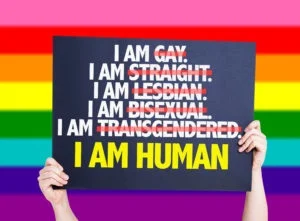
Guest post by MJ Lisbeth
“I don’t think I believe in God anymore.”
She uttered those words in the way a kid might curse for the first time: as if she were looking over her shoulder, anticipating a rebuke, a slap in the face, or worse. It’s the way I made two of the most important (at least, they seemed that way) declarations of my life: that I am bisexual and transgender.
And her face expressed the same kind of bewilderment and relief I felt after “coming out.” She must have known that any retribution, punishment, or other negative reactions and other consequences for disavowing what she’d believed all of her life wouldn’t come from me. Rather, she was probably thinking about the people—some of whom, like her mother, she loved dearly—who inculcated her with the faith she’d had all of her life and nurtured and supported her in other ways.
Like me, she was raised Roman Catholic and attended Catholic schools. Also in common with me, the church was central to her upbringing because of her ethnic heritage (like mine, mostly) and the community in which she grew up.
In other ways, though, she is about as different from me as one could be. For one, she never left her social, ethnic, and economic milieu, always living in it, if in different neighborhoods of the city (New York) in which we were raised and which we call home. I have lived in small towns and rural areas, as well as urban areas, in New Jersey, California, and France. I have traveled to about two dozen other countries; she has never left, and never really wanted to leave, the United States “except for Paris or London.” Her formal education ended with a secretarial school; I hold a master’s degree and started a Ph.D. And, perhaps more relevant to this essay, she has never been a part of any church or religion other than the one in which she was raised and, like most Catholics of her (and my) generation, never read the Bible, let alone studied theology. I, on the other hand, have been part of an Evangelical Church (where I made a declaration that I would “devote my life to Christ” and led a Bible study), read some theology and explored, as a result of my short-lived marriage and my own quest for truth and meaning, other religious traditions.
Oh, and her marriage was, perhaps, an even bigger contrast than other parts of her history to mine: At age 19, she was wed to the man she met two years earlier and with whom she would remain until his death. Along the way, they would have two daughters. My marriage lasted the length of an American Presidential term and resulted in no progeny.
(Should I also mention that she has never ridden a bicycle—I am a lifelong cyclist– and cannot understand why anyone would want to hike, camp, climb or spend any time in the countryside of one of the world’s poorest countries, as I have?
From what I’ve said so far, it might surprise you to hear that the woman I’ve described is my closest friend and confidante. Her husband was also a close friend and, in some ways, as different from me as she is: He earned his GED in the Army (into which he was drafted) and drove trucks for a living. Like her, he was raised Catholic, though in a different cultural tradition, and never left his social and economic roots.
So, you might wonder: How did they and I bond? Well, twenty years ago next month, I moved next door to them. As my now-former partner and I were carting my possessions into my new residence—and I was entering a new phase of my life—she struck up a brief conversation with me when I lugged one cat carrier, then another, into my new apartment. Turns out, she volunteers with a local animal-rescue organization, from which she and her husband adopted several cats.
A few days later, she asked me over for lunch. I accepted, in part because I knew no one else in the neighborhood, but also because I knew, instinctively, that we “got” each other. After that meal, I wept: It reminded me of Sunday afternoons from my Italian-American childhood and French families who befriended me. In other words, the food was complex but not complicated, made with love, or at least passion. In other words, it was a reflection of the people who made it.
I would share many more meals—including holiday repasts—with her, her husband and kids, grandkids, and friends, over the years. Since her husband passed and her daughters and grandkids moved away, we have shared brunches, dinners, walks in local parks, and—this is less surprising than I expected—museum visits. She and I share a passion for Auguste Rodin’s sculptures (especially “Je suis belle”). As I came to know her, that love of hers is less contradictory than it seems: She has no formal or academic training, but she understands, intuitively, a thing or two about life and love, death and loss.
Which, I believe, is why her expression of doubt about the god in which she had been raised to believe surprised me less than I thought it might. She is a decade and a half older than I am and, because she gave birth to, and raised children, endured struggles that I will never understand. But, more to the point, I had long suspected that she has an “inquiring mind” that “wanted to know.” While she doesn’t express anger, resentment, or regret about her life, I can’t help but wonder whether her wish to know—or more important, to understand—was suppressed because she was a girl in the environment in which she grew up and because she wasn’t a “good student”—which, I know all too well, has absolutely nothing to do with being intelligent or inquisitive, let alone having any sort of integrity.
I don’t try to steer her toward or away from believing or not believing. (For that matter, I doubt that I can so influence her.) All I can do is to be present for her, as she has been for me. Whatever she decides—or whether or not she decides—I can understand. I am simply happy that she is asking questions and thinking for herself.
Bruce Gerencser, 68, lives in rural Northwest Ohio with his wife of 47 years. He and his wife have six grown children and sixteen grandchildren. Bruce pastored Evangelical churches for twenty-five years in Ohio, Texas, and Michigan. Bruce left the ministry in 2005, and in 2008 he left Christianity. Bruce is now a humanist and an atheist.
Your comments are welcome and appreciated. All first-time comments are moderated. Please read the commenting rules before commenting.
You can email Bruce via the Contact Form.

